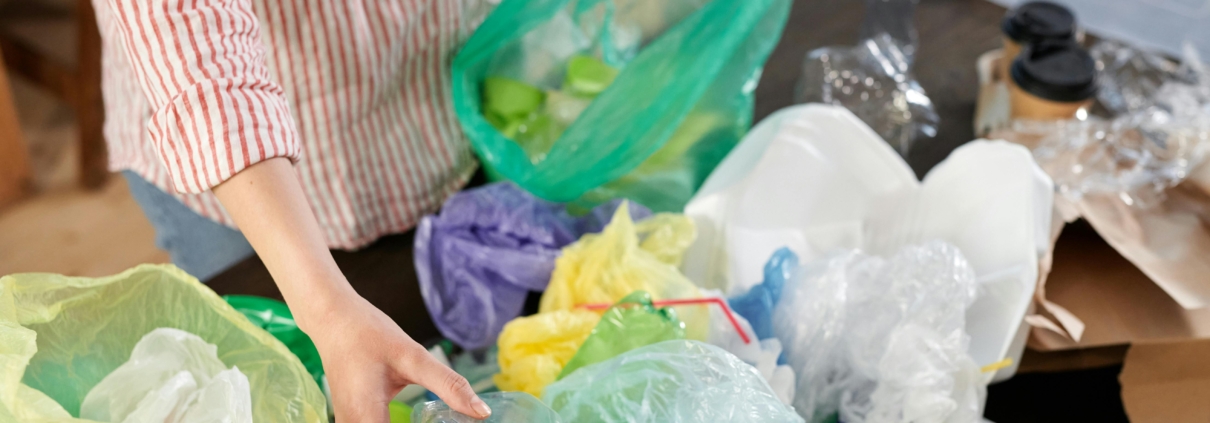What is Low Density Polyethylene (LDPE) and how is it recycled?

Low-density polyethylene (LDPE) is a plastic material widely used in various applications, especially in packaging and everyday products. Its flexibility and strength make it a popular choice in the industry. From production to recycling, LDPE has features that make it versatile and essential. This article explores their properties, uses and the importance of recycling them in a sustainable environment.
Low-density polyethylene has become an essential material in various applications. Its origin and distinctive characteristics contribute to its wide acceptance in industry and in everyday life.
Origin and characteristics of low-density polyethylene
LDPE Production Process
Low-density polyethylene is obtained through a process of polymerization of ethylene, a compound derived from petroleum. Since its introduction to the market in 1933, the production method has evolved, focusing mainly on two approaches: high-pressure polymerization and polymerization using free radicals in autoclaves or tubular reactors.
The high-pressure process, which exceeds 1,000 bar, allows ethylene molecules to bond together to form long, branching chains. This branching is what gives LDPE its less dense structure compared to high-density polyethylene (HDPE). This process results in a material that exhibits unique properties, such as remarkable flexibility and lower rigidity, characteristics that make it ideal for a variety of applications.
Physical and chemical properties
The properties of low-density polyethylene are key to its use in multiple sectors. The physical and chemical characteristics that are considered most relevant are:
Flexibility and impact resistance
One of the most outstanding properties of LDPE is its high flexibility. This feature allows it to bend and conform to different shapes without breaking, which is critical in applications such as plastic bag and packaging manufacturing. Its ability to resist impact also gives it a toughness that improves durability in various conditions.
Thermal stability
Low-density polyethylene offers good thermal stability, withstanding temperatures ranging from -50°C to 85°C. It performs well in more extreme conditions, as it can withstand up to 290°C in the absence of oxygen. However, it is important to note that higher temperatures can cause the decomposition of the material, resulting in lower molecular weight products. Therefore, their handling requires attention to temperature to prevent degradation.
Low crystallinity
The low crystallinity of LDPE is another of its key characteristics. Unlike other plastics that have a regular, crystalline structure, LDPE has an amorphous structure that contributes to its flexibility and toughness. This property allows it to melt at lower temperatures, facilitating its manufacturing process in various applications. The amorphous nature of the material gives products made from this polymer a soft and flexible feel, which is highly appreciated in the packaging industry.
Main Uses of Low-Density Polyethylene
This material has become a crucial component in various industries thanks to its unique properties. Its versatility allows low-density polyethylene to be used in multiple applications, especially in packaging and household products.
Applications in the packaging sector
One of the areas where LDPE has the greatest impact is in the production of packaging. Its flexibility, strength and sealability make it the ideal choice for multiple packaging applications.
Grocery bags and trash
Plastic grocery and trash bags are probably the most visible examples of LDPE use. The lightness and durability of these bags allow for efficient transport of goods. In addition, the tear resistance offered by this material minimizes the risk of spills.
Food packaging
Low-density polyethylene is common in the manufacture of food packaging. It is used to create films that protect various food products, thus prolonging their shelf life. Its ability to resist moisture and air makes it ideal for maintaining freshness in fruits, vegetables, and other perishable products. This is essential in a market where presentation and preservation are essential for the consumer.
Uses in Household Items
LDPE is not only limited to packaging, but is also found in a variety of everyday household products. Its chemical resistance and flexibility make it a preferred material for different applications.
Detergents and other chemicals
Detergent and cleaning supplies packaging is usually made of low-density polyethylene. Their resistance to chemicals allows these containers to be safe and effective. This is critical to protect both the content and the user during handling. In addition, the transparency of LDPE allows for easy identification of the contents on store shelves.
Other household products
LDPE is also used in a wide range of household products, such as toys and cookware. Its lightness and flexibility make it attractive for the manufacture of items that require conformity and adaptability. These products benefit families by offering safety and ease of use.
Electrical and automotive sector
In the industrial field, low-density polyethylene plays a prominent role in the electrical and automotive sectors, where its physical properties contribute to the efficiency and safety of different applications.
Electrical insulation in cables
LDPE is commonly used as an insulation material in electrical wires. Its low electrical conductivity makes it ideal for preventing short circuits and ensuring the safety of electrical installations. This use is especially important in environments where additional protection from moisture and other environmental factors is required.
Automotive Parts & Components
In the automotive industry, low-density polyethylene is used in the manufacture of various components. Thanks to its ability to be molded and its resistance to impact, it is used in parts such as coatings, upholstery and other elements of the vehicle’s interior. Its versatility and adaptability are key to meeting the safety and comfort standards required in the automotive sector.
Importance of recycling low-density polyethylene
Recycling low-density polyethylene is essential to promote sustainability and reduce environmental impact. This process not only helps conserve resources, but also contributes to the circular economy.
Recycling process and its benefits
Identification and classification code
Low-density polyethylene is classified with the Plastic Identification Code 4, a system that facilitates its identification during recycling processes. This code allows consumers and businesses to quickly differentiate LDPE from other types of plastics, thereby incentivizing more effective collection and treatment. Knowledge of these classifications is critical to improving recycling rates and ensuring that materials are treated correctly.
Production of recycled granules
Once collected, LDPE goes through a recycling process where it is transformed into recycled pellets. This process involves several stages, including cleaning, crushing, and melting the material. The resulting pellets can be used in a variety of applications, which not only reduces the demand for new plastic, but also decreases the volume of waste that ends up in landfills and oceans.
The production of recycled pellets from LDPE offers multiple benefits, such as:
- Conserving natural resources by decreasing the need for oil extraction to produce new plastic.
- Reduced carbon footprint, as recycling generates fewer greenhouse gas emissions compared to the production of virgin plastic.
- Generation of employment in the recycling sector, contributing to the local economy.
Challenges and opportunities in recycling
Environmental impact
Despite the benefits of recycling low-density polyethylene, there are several challenges that need to be addressed. One of the main problems is the contamination of recyclable materials. LDPE is often mixed with other types of plastics that are not recyclable, complicating their treatment and decreasing the quality of the recycled material. Education on the correct separation of waste is essential to improve the efficiency of recycling.
Development of recycling infrastructure
Another major challenge is the recycling infrastructure available. In many localities, adequate facilities for LDPE processing may be limited. Investment in technology and the creation of recycling centres specialising in flexible plastics is crucial. Collaboration between governments, industries and communities can encourage the development of a more robust infrastructure that facilitates the recycling of this type of plastic.
The opportunities are also significant. Growing awareness of environmental issues drives innovation in recycling and the improvement of the techniques used. New technologies that maximize the recycling efficiency of LDPE are being investigated, which could open up new avenues for its reuse. This advancement in technology could transform the recycling landscape, becoming the foundation for a more sustainable future in plastics management.
The future prospects for low-density polyethylene (LDPE) in a sustainable context are promising. The search for sustainable alternatives and the adoption of innovative technologies are at the heart of its evolution.
Future prospects for LDPE in a sustainable context
Technological innovations and their applications
Advances in technologies related to the production and recycling of LDPE are leading to the creation of materials with improved properties. This not only translates into superior performance, but also allows for the expansion of its uses in various industries.
Improved strength and specific properties
New polymerization methods and advanced formulations are resulting in versions of LDPE that are more resistant to wear and harsh environmental conditions. These improvements are critical for more demanding applications, where material durability is crucial.
Applications in advanced technologies
LDPE is beginning to play an important role in innovative technologies. For example, in the automotive industry and in the manufacture of electronic devices, the material is used for its lightness and flexibility. Current research seeks to apply this polymer in electric vehicle components and in medical devices, where transparency and safety are essential.
Market trends and environmental awareness
With the rise in environmental awareness, the market is shifting towards more sustainable practices. This encompasses both the way LDPE is produced and used, as well as the management of its lifecycle at the end of its use.
Expanding sustainable use
Consumer trends are driving the use of recycled LDPE in new products. This fosters a circular economy that considers not only efficiency in production, but also environmental impact. Consumers are increasingly interested in products made from recycled raw materials, which drives demand for recycled LDPE and thereby improves recycling rates for the material.
Business strategies for the circular economy
Companies are implementing strategies that advocate for sustainability at every stage of the product cycle. This includes from initial production to the end of the LDPE’s shelf life. Initiatives range from design for recycling, where you consider how the product will be handled when disposing of it, to collaborating with recycling centers to ensure that LDPE is recovered and reprocessed efficiently. Brands are integrating this philosophy into their business approach, highlighting their commitment to the environment and thus attracting conscientious consumers.
Are you interested in improving the management of plastic waste such as LDPE in a sustainable and efficient way? At Reverter Industries we have packaging recycling plants specially designed to process materials such as low-density polyethylene.





